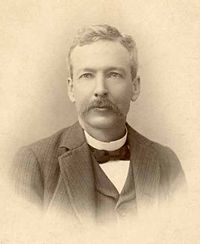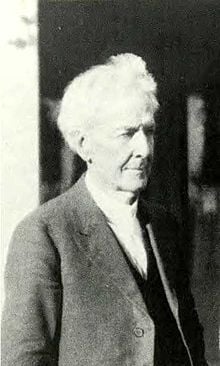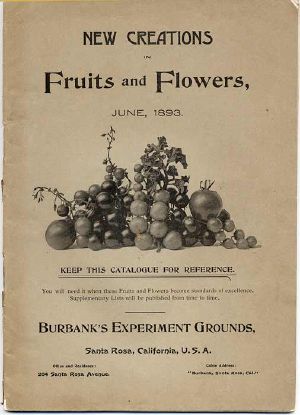Luther Burbank
Luther Burbank (March 7, 1849–April 11, 1926) was an American horticulturist. He developed more than 800 strains and varieties of plants over his 55-year career.
Life and work
Luther Burbank was born in Lancaster, Massachusetts. His father, Samuel Burbank, was a farmer and a brickmaker. His mother, Olive Ross Burbank, was Samuel's third wife; the first two having passed away leaving five children. From his childhood Burbank loved plants and often gathered the seeds of wildflowers to grow at home. After finishing school and trying factory work, which was bad for his health, he bought a small plot of land and started to grow vegetables for market.
In 1872 Burbank found a seed ball on one of the potato plants in his garden. (Potato plants only rarely produce seeds.) One of the seeds produced a new variety of potato which was named the Burbank potato. Burbank sold the new potato to a seed dealer for $150. A natural sport (genetic variant) of the Burbank potato with russet (reddish-brown) skin later became known as the Russet-Burbank potato: this large, brown-skinned, white-fleshed potato has become the predominant processing potato in the United States. McDonald's french fries are made exclusively from this cultivar.
In 1875 Burbank decided to move to California, partly because three of his brothers lived there and partly because he felt the climate and conditions there were better for horticultural work. He settled in Santa Rosa and soon purchased a four acre plot of land on which he started a nursery business.
Burbank's real interest was not just in growing plants but in trying to improve them and make them more useful to humankind. He was inspired by the books of Charles Darwin and by the whole concept of evolution. He latter said that his one sentence from Darwin's book The Effects of Cross- and Self-Fertilization in the Vegetable Kingdom was his "starting point":
- As plants are adapted by such diversified and defective means for cross-fertilization, it might have been inferred from this fact alone that they derived some great advantage from the process; and it is the object of the present work to show the nature and importance of the benefits to be derived.
Burbank's method was to cross-pollinate plants of different varieties and even different species, to grow large numbers of the new hybrids, and to select the best plants of the new generation to start a new variety. He had hundreds of experimental plantings, and many thousands of plants, at any one time. Part of the reason for his success is these large numbers and part is his own special genius in knowing what crosses to try and which of the offspring to select for further work.
Burbank's most successful strains and varieties include the Shasta daisy, the Fire poppy, the July Elberta peach, the Santa Rosa plum, the Flaming Gold nectarine, the Burbank plum, the Freestone peach, and the Burbank potato. Burbank also bred the white blackberry and the nectarine. One his most famous creations is the spineless cactus, which provides food for both cattle and people. He had high hopes that this would revolutionize agriculture in desert regions and help to end world hunger. It was not quite the success he had hoped but it is still being grown in many places.
Burbank's creations included: Fruits
- 113 plums and prunes
- 35 fruiting cacti
- 16 blackberries
- 13 Raspberries
- 11 quinces
- 11 plumcots
- Ten cherries
- Ten strawberries
- Ten apples
- Eight peaches
- Six chestnuts
- Five nectarines
- Four grapes
- Four pears
- Three walnuts
- Two figs
- One almond
Grains, grasses, forage
- Nine types
Vegetables
- 26 types
Ornamentals
- 91 types
Thoughout his career Burbank struggled with the business side of his work. He wanted his work to be profitable but at that time plant varieties were not patentible so he had to sell the individual plants and seeds, directly to farmers and gardeners and indirectly though retailers such as the Burpee Seed Company.
Burbank was criticized by scientists of his day because he did not keep the kind of careful records that are the norm in scientific research and because he was mainly interested in getting results rather than in basic research. Jules Janick, Ph.D., Professor of Horticulture and Landscape Architecture, Purdue University, writing in the World Book Encyclopedia, 2004 edition, says: "Burbank cannot be considered a scientist in the academic sense."
By all accounts Burbank was a kindly man who cared about other people. He gave quite a bit of money to the local schools. He married twice: To Helen Coleman in 1880, which ended in divorce in 1896, and to Elizabeth Waters in 1916. He had no children.
Burbank also had a mystical, spiritual side. He said in a speech to the First Congregational Church of San Francisco in 1926:
- I love humanity, which has been a constant delight to me during all my seventy-seven years of life; and I love flowers, trees, animals, and all the works of Nature as they pass before us in time and space. What a joy life is when you have made a close working partnership with Nature, helping her to produce for the benefit of mankind new forms, colors, and perfumes in flowers which were never known before; fruits in form, size, and flavor never before seen on this globe; and grains of enormously increased produtiveness, whose fat kernels are filled with more and better nourishment, a veritable storehouse of perfect food &endash new food for all the world's untold millions for all time to come.
Burbank died in 1926 from a heart attack and a gastro-intestinal condition.
Legacy
Burbank's work spurred the passing of the 1930 Plant Patent Act four years after his death. The legislation made it possible to patent new varieties of plants (excluding tuber-propagated plants). In supporting the legislation, Thomas Edison testified before Congress in support of the legislation and said that "This [bill] will, I feel sure, give us many Burbanks." The authorities issued Plant Patents #12, #13, #14, #15, #16, #18, #41, #65, #66, #235, #266, #267, #269, #290, #291, and #1041 to Burbank posthumously.
In 1986, Burbank was inducted into the National Inventors Hall of Fame. The Luther Burbank Home and Gardens, in downtown Santa Rosa, are now designated as a National Historic Landmark.
The town of Burbank, California, does not take its name from Burbank, but from the Los Angeles dentist David Burbank; however, the horticulturist gave his name to Luther Burbank Middle School in Burbank. The Luther Burbank School District in San Jose and Santa Rosa's Luther Burbank Rose Parade and Festival also honor Luther Burbank. Santa Rosa used to have a performing arts center named after Burbank, but Wells Fargo bought naming rights for $3.2 million in 2006 and renamed it. The Lancaster Middle School in Lancaster, Massachusetts was renamed to Luther Burbank Middle School in 2003.
The University of Wisconsin Digital Collections Center has digitized and published online the 12-volume monographic series Luther Burbank: His Methods and Discoveries, which documents Burbank's methods and discoveries and their practical application.
In 1931 the Boys Parental School located on Mercer Island, Washington changed its name to Luther Burbank School. The school continued to function until 1966. The land on which the school was built was bought by King County and converted into Luther Burbank Park.
The standard botanical author abbreviation for Burbank consists simply of "Burbank".
ReferencesISBN links support NWE through referral fees
- Kraft, Ken & Pat. Luther Burbank, the Wizard and the Man. New York : Meredith Press, 1967
- Yogananda, Paramahansa. Autobiography of a Yogi. Los Angeles : Self-Realization Fellowship, 1946 ISBN 0876120834
External links
- Luther Burbank Virtual Museum
- Luther Burbank Home and Gardens official website
- National Inventors Hall of Fame profile
- Wells Fargo Center for the Arts (formerly the Luther Burbank Center for the Arts)
- UN report on spineless cactus cultivation in Tunisia
Credits
New World Encyclopedia writers and editors rewrote and completed the Wikipedia article in accordance with New World Encyclopedia standards. This article abides by terms of the Creative Commons CC-by-sa 3.0 License (CC-by-sa), which may be used and disseminated with proper attribution. Credit is due under the terms of this license that can reference both the New World Encyclopedia contributors and the selfless volunteer contributors of the Wikimedia Foundation. To cite this article click here for a list of acceptable citing formats.The history of earlier contributions by wikipedians is accessible to researchers here:
The history of this article since it was imported to New World Encyclopedia:
Note: Some restrictions may apply to use of individual images which are separately licensed.


